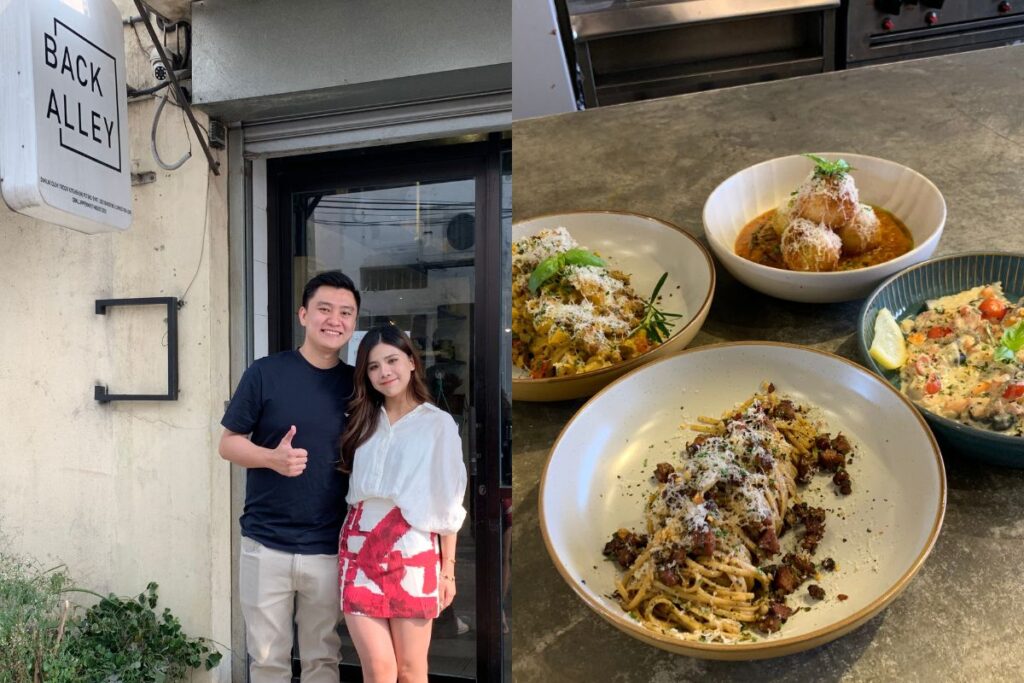Back Alley Pasta Bar didn’t start with flashy launches or viral campaigns. It began with a simple idea, a small savings pool, and a team determined to build something real.
No big investors. No loans. Just a tight-knit crew and an 8-seater space tucked away in the heart of KL.
Today, it’s one of the city’s most sought-after pasta restaurants — a neighbourhood gem that’s gone from underground favourite to must-visit destination. But getting here wasn’t a straight path. It took years of hands-on leadership, tough lessons, and a commitment to doing things the hard (and right) way.
Here’s how they did it.
Starting Small Without Loans or Hype

Back Alley Pasta Bar opened during a time when many new restaurants were chasing trends or launching with massive capital. But the goal for this team wasn’t to go viral — it was to build something lasting.
Leading the business are three people who wear many hats: Alfred, the Managing Director; Mia, who heads marketing (and is also Alfred’s wife); and Wai Yoong, who manages finance (Alfred’s younger brother). While it may look like a family business from the outside, they run it with the structure and discipline of a company — clear roles, defined investments, and agreements in place to avoid the typical pitfalls of family-run ventures.
The brand first launched as an 8-seater chef’s table, serving handcrafted pasta in an intimate, omakase-style format. And from day one, they made a bold decision: no loans. Every ringgit earned was reinvested into the business to grow it slowly — and sustainably.
As Alfred shared, “Because honestly, operating a full-fledged restaurant is not a one-man show. You need marketing, you need operation, you need a chef, of course. You need a cleaner also. You need finance. So, it’s not a one-man show.”
Instead of banking on gimmicks or hype-driven campaigns, the team focused on what mattered: flavour, service, and the overall dining experience. And as word spread, bookings started filling up — not because of buzz, but because people came back. Again and again.
Popularity Brings Pressure — But So Do Rising Costs

Back Alley Pasta Bar grew from a humble chef’s table to one of KL’s most recognisable pasta restaurants — with steady bookings and a loyal following. But with popularity came pressure.
Customers began arriving with big expectations, sometimes drawing comparisons to renowned international restaurants. The team knew they had to deliver more than just great pasta — they had to deliver consistency, service, and an experience that lived up to every plate that came before.
Meanwhile, the realities of the F&B industry set in. The cost of high-quality ingredients — especially imported ones — continued to rise. So did rent and wages. Margins tightened. Every decision became a balancing act between maintaining quality and staying profitable.
Instead of cutting corners, the team chose to invest where it mattered — in their people.

Alfred created space for younger chefs to grow by giving them ownership and creative freedom in the kitchen. He encouraged them to pitch ideas, test new flavours, and learn by doing. One example is their signature arancini — a dish that evolves regularly, shaped by the team’s experimentation and input.
That approach didn’t just keep the menu fresh. It built a culture where the team felt trusted and motivated to take pride in every dish served.
By building a kitchen that runs on shared responsibility and respect, Back Alley Pasta Bar kept their standards high — even when the pressure was higher.
Mistakes Were Made — But That’s What Built Them

There was no master plan for Back Alley Pasta Bar — just a vision, a lot of grit, and a willingness to figure things out along the way.
In the early days, even something as simple as managing reservations became a challenge. Bookings were done manually over WhatsApp and Instagram DMs, which made it hard to keep track, manage no-shows, or plan ahead efficiently. It worked — until it didn’t. As demand grew, the system cracked under pressure.
That was one of many turning points.
Instead of getting overwhelmed, the team adapted. They switched to a proper reservation platform that gave them more control over guest flow and allowed for better prep and service.
They also expanded their space. From a tight 8-seater, Back Alley Pasta Bar grew into a restaurant that now seats 50 — a big jump, but one that came with intention. Scaling up without compromising quality meant reassessing everything: workflows, staff responsibilities, kitchen output, and customer experience.
It wasn’t perfect from the start. But that was the point.
Every growing pain taught them something — how to communicate better with guests, how to manage service flow during peak hours, how to refine their dishes based on feedback. They didn’t wait for the “perfect time” to improve. They took risks, made changes, and got better each time.
Redefining Success In The F&B Industry

In the beginning, their idea of success looked a lot like growth. More bookings. More reviews. More buzz.
But after years of being in the thick of it — the long shifts, the hiring challenges, the changing customer expectations — their definition evolved.
Now, success looks like a full team that believes in what they’re doing. A kitchen that runs smoothly even on the busiest nights. Customers who keep coming back, not because they saw an ad, but because they trust the experience.
As Mia put it: “What you can control is the consistency of your food, the food that you deliver, and that’s the main thing to keep a business sustainable instead of hype.”
What Back Alley Pasta Bar built is something that lasts — not because of trend-driven spikes or viral fame, but because they kept showing up, kept improving, and kept choosing the long game.
And in an industry known for burnout and high turnover, that’s the most meaningful kind of success of all.



